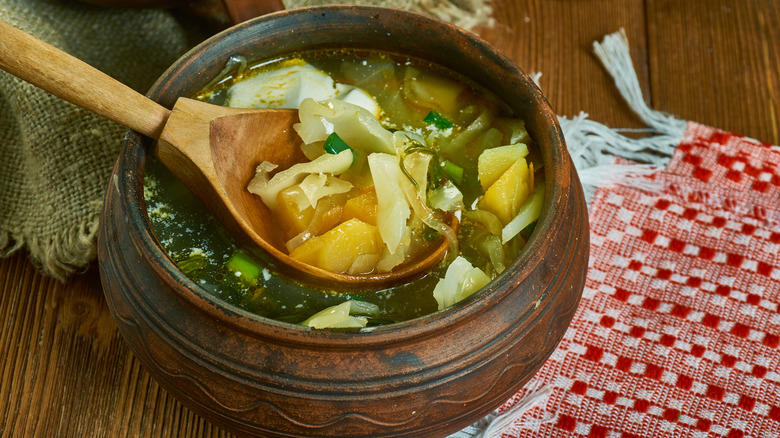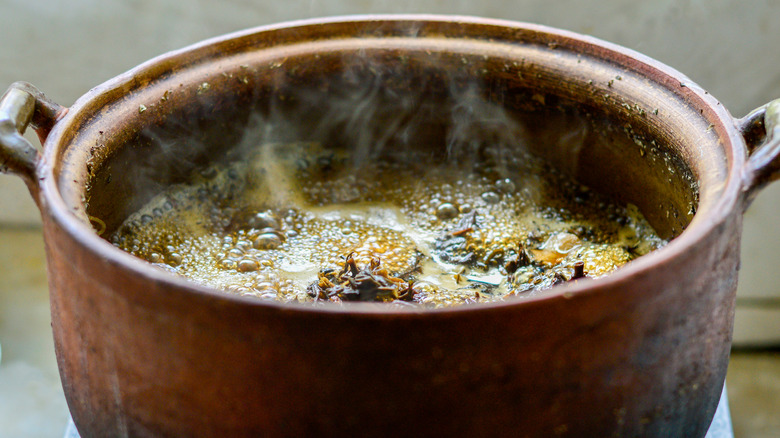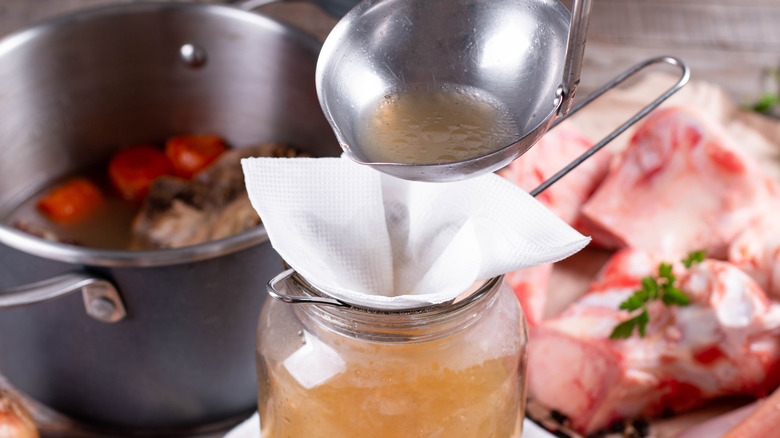The Truly Ancient History Of Soup
Soup can feel like a timeless food. Many people have fond memories of eating basic soups as a child (especially when sick). Plus, the varieties are practically endless, so there's pretty much a soup for every season. It's not merely biographical or seasonal, either. The history of soup is so ancient it drips down far into the prehistory of humankind.
One can easily imagine why. According to the Encyclopedia Britannica, soup is just liquid food made by heating up almost anything from fish, meat, and poultry to vegetables, legumes, or even fruit in water, milk, or any other edible fluid. Whether thick or thin, soup really has got it all. It's usually a simple and extremely flexible culinary canvas, leading to myriad types like bisque, chowder, gumbo, minestrone, and vichyssoise. There are hundreds of iterations worldwide, per Onmanorama. Plenty of them are good for you in one way or another, thanks to their nutritional content, plus the long simmering time and common simplicity of soups make them easy to digest. No wonder even early humans ate the stuff!
Soup is one of the first culinary creations
The origins of cooking are as clouded as a hazy broth. National Geographic notes our ancestors started tossing food, likely meat, onto fires millions of years ago. Whether it was through banging rocks together to create sparks or grabbing a bit of flame from wildfires, prehistoric peoples managed to make their rations both healthier and tastier this way. Then, in the Paleolithic Period — the late Stone Age — things got a bit more sophisticated with the development of stone hearths.
Soup entered the scene tens of thousands of years ago (via NPR). Sources like Encyclopedia Britannica and Onmanorama note that clay pottery and mud vessels let folks mix liquid and solid foods together to heat them up, at first by dropping hot rocks into the concoctions. However, it's possible that even before that, animal hides or stomachs, dirt pits, and tree bark could have been used as bowls. Then, at first in ancient China, heat-resistant pots were invented, which allowed fire to be the primary heat source for food yet again.
The future of soup is bright
Time marches ever onward and so does the evolution of soup. As juggernaut in the field Campbell's Soup explains, ancient civilizations like China in the east and the Roman Empire in the west helped usher this culinary tradition through the annals of history, spreading it far and wide. Soup endured through the Middle Ages and then benefitted from the invention of the soup spoon during the European Renaissance; evolving fashion made it harder to lift bowls past stiff collars, so utensils became necessary. Later, during the 1700s, French vendors sold soups as restoratives, a tradition that actually gave rise to the modern restaurant. Incidentally, the word "soup" comes from the French term "soupe," which stems from the Roman's informal Latin term "suppa," per Onmanorama. Things truly took off in the 19th century, when canned soup was made possible, and again in the 20th century, when dried, ready-to-be-boiled soup ingredients like ramen noodles were created. Who knows what the 21st century will bring to soup?
Nonetheless, soup's ancient roots have not been entirely forgotten. As recently as 2015, the New York Times reported Paleo diets (as in Paleolithic) were reintroducing the delights of basic, primordial soups. Many individuals are now using bones to make stocks, traveling back in time via their taste buds. Past, present, and future, soup is always in style.


